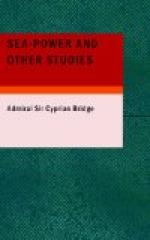When it was expected that the British fleet would comprise forty sail-of-the-line and the enemy’s fleet forty-six, each British main division was to be made up of sixteen ships; and eight two-deckers added to either division would increase the strength of the latter to twenty-four ships. It is interesting to note that, omitting the Africa, which ship came up late, each British main division on the morning of 21st October 1805 had nine ships—a number which, by the addition of the eight already mentioned as distinct from the divisions, could have been increased to seventeen, thus, except for a fraction, exactly maintaining the original proportion as regards the hostile fleet, which was now found to be composed of thirty-three ships.
During the night of 20th-21st October the Franco-Spanish fleet, which had been sailing in three divisions and a ’squadron of observation,’ formed line and stood to the southward, heading a little to the eastward of south. The ‘squadron of observation’ was parallel to the main body and to windward (in this case to the westward) of it, with the leading ships rather more advanced.
The British main divisions steered WSW. till 1 A.M. After that they steered SW. till 4 A.M. There are great difficulties about the time, as the notation of it[86] differed considerably in different ships; but the above hours are taken from the Victory’s log. At 4 A.M. the British fleet, or rather its main divisions, wore and stood N. by E. As the wind was about NW. by W., the ships were close-hauled, and the leader of the ‘lee-line,’ i.e. Collingwood’s flag-ship, was when in station two points abaft the Victory’s beam as soon as the ‘order of sailing’ in two columns—which was to be the order of battle—had been formed.
[Footnote 86: Except the chronometers, which were instruments of navigation so precious as always to be kept under lock and key, there were no clocks in the navy till some years after I joined it. Time on board ship was kept by half-hour sand-glasses.]
About 6 A.M. the enemy’s fleet was sighted from the Victory, and observed to bear from her E. by S. and be distant from her ten or twelve miles. The distance is corroborated by observed bearings from Collingwood’s flag-ship.[87] Viewed from the British ships, placed as they were relatively to it, the enemy’s fleet must have appeared as a long single line-ahead, perhaps not very exactly formed. As soon as the hostile force was clearly made out, the British divisions bore up and stood to the eastward, steering by the Victory’s compass ENE. The position and formation of the British main divisions were by this made exactly those in which they are shown in the diagram usually attached to the celebrated memorandum of 9th October 1805. The enemy must have appeared to the British, who were ten or twelve miles to windward of him, and on his beam, as if he were formed in line-ahead. He therefore was also in the position and formation assigned to him in that diagram.




